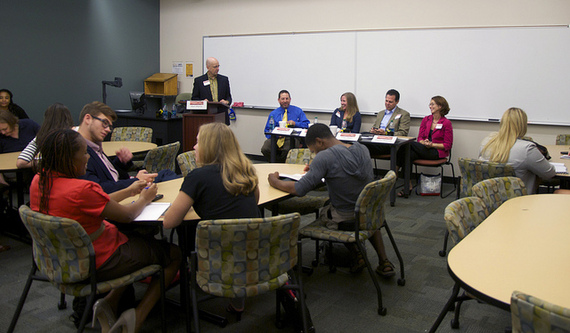Image by Cait Barron via Flickr
Let's be frank: accounts, engineering, marketing, and sales all often have a hard time understanding one another, even if they "get along" just fine.
"Working in a particular profession, you get trained to think, analyze and operate in a particular way," says Dr. Alison Whybrow, an award-winning psychologist who coaches senior and high potential leaders across industry sectors. Many times, those same attitudes and procedures run counter to how folks in other departments function. "In a busy, complex and frequently changing work environment, [workers are] just not aware that their colleagues are looking at a different landscape." This creates friction between departments and communication strain.
Below are seven tips business owners, department managers and individual workers can use to enhance interdepartmental communications.
Offer context
Meetings are unproductive when half of the attendees have no idea what is going on. To keep everyone on their toes, it is important to provide powerful context that will really rally troops together.
Dr. Whybrow advises, "Step back from the task in each meeting or interaction, and jointly define what a good outcome would look like for both or all parties involved. What is the purpose of the meeting in the first place and how does it relate to achieving the wider organizational purpose?" Doing so offers direction so team members can actively participate instead of passively nodding their heads, watching the minutes tick by.
Exercise empathy
Mutual understanding plays an important role in fostering stronger interdepartmental communications, too. "Step into the other's shoes," recommends Dr. Whybrow. "If you're an engineer meeting with a sales person, take a moment to consider, what does this look like from the salesperson's perspective. What are the pressures on him / her that this situation creates? What would success look like for him / her?"
With empathy, folks in different teams may come together to support their respective long-term goals and visions. Collectively, they are better equipped to drive meaningful results for their employer.
Embrace confusion
Of course, confusion does not have to be the enemy.
"Confusion is fine; it's a healthy part of a learning process," says Martin Echavarria of the boutique consultancy. "If confusion exists, it is most productive to acknowledge that there is confusion." Set your pride aside and admit when you are unable to follow a conversation or train of thought. Some people get lost in their own words; no one will fault you for requesting clarity about a conversation, email thread or project.
"The goal should never be to minimize something that can be considered negative, but rather to build the capability to work together," continues Echavarria. "In this way, the collective muscle to respond effectively to change and remain resilient through challenge is fostered. Problems and challenges to collaboration always exist. The best solution is learning together to respond productively when they occur."
Manage your emotions
Constructive dialogue is a critical component of personal and team development. But invalidating responses and verbal attacks drive resentment, not results. "Allow people to disagree and express emotions, empathy is one, but one that is often not allowed is anger and disappointment. Negative emotions expressed can be great opportunities to open the possibility for positive change," says Echavarria.
Avoid being defensive too. An open mind toward criticism benefits interdepartmental communications by prioritizing organizational goals over ego.
Develop a common language
Meaningless buzzwords kill conversations. New vocabulary should be considered carefully and used sparingly. While certain things make sense within your functional milieu, department-specific language alienates outsiders.
Echavarria suggests, "Clarify and agree to terminology and language as it is used in [meetings]. This ensures everyone understands what is being said. Try to minimize jargon, or unproductive normative comments that occur in corporate culture, but no one really understands." The consequence of using unique or ambiguous terms is teams end up having different dialogues. Sales may misinterpret messages from marketing. Alternatively, people may tune out of conversations entirely.
To engage everyone effectively, companies should develop a common language everyone understands, which should be used to improve cross-functional communications.
Intermingle
Cliques happen. At their desks, at the lunch table and in meetings, you see folks hanging out with peers in the same departments. To champion a more collaborative environment, create situations that encourage intermingling.
At your next meeting, assign seats to get people sitting next to unfamiliar colleagues. Instead of playing host to residents from different neighborhoods, you form a more cohesive and diverse group of professionals who truly understand each other. Also, remind your colleagues to "shut down all laptops and cell phones and be there to connect with others," urges Echavarria.
Craft the right response
To minimize misinterpretation, professionals need to be aware of their own communication style and must understand "how to most effectively engage their colleagues' style," says Lisa Chenofsky Singer, a certified executive coach. Two tips she offers are:
- Write [an] email response and save it in draft to review 5 minutes later, asking yourself if you addressed the questions asked or responses to the inquiry offering useful information.
- See if this response is better handled via phone or in person when possible, as you can pick up nuances that writing does not. You can always follow up with a confirmation email.
Sometimes the method in which you communicate is as important as your content. Take the time to ensure accurate interpretation and smoother collaboration; it will be well worth it.
This post originally appeared on the Central Desktop blog and is republished with permission.
****
Danny Wong is the co-founder of Blank Label, an award-winning luxury menswear company. He is also a digital marketing consultant and freelance writer. To connect, tweet him @dannywong1190 or message him on LinkedIn.

